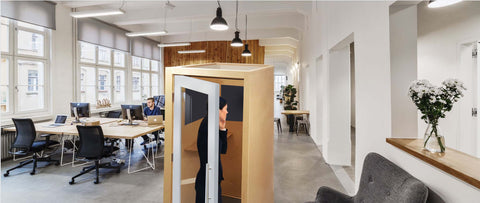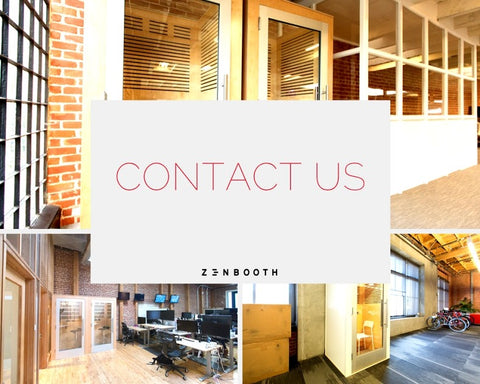For too many years, the benefits of agile office design have been ignored. Instead, workplaces have been built on principles that do not support good employee productivity, happiness, or business success.
A floor full of identical, separated cubicles are a waste of space, discourage collaboration and a feeling of team camaraderie. They also contribute to employee burnout and low productivity overall.
In response to this negative trend, companies that were looking to shake things up turned to open office floor plans. Rather than cubicles, they had desks in rows where everyone could work and see their team members. In theory, this was an improvement, but in reality, it brought a host of difficulties.

Factors like loud spaces, no space for small meetings, no ability to step out and quickly recharge before returning to work, and no way to participate in conference calls or other telecommunication without disturbing the entire office lead to many of the same problems we see with rigidly designed cubicle spaces. Absenteeism, low productivity, and burnout can all plague open floor plan offices.
An agile workspace is something different. This new concept blends the best parts of individualized workspaces and coworking collaborative environments to create a new kind of environment that fosters productivity and creativity. It is not a one-size fits all approach to office design; each team will need a different style of agile office design to really thrive.
This is because an agile workspace is more than a floor plan; it's a design concept. To get a really great agile workspace, your company should work with a high quality designer familiar with the concepts and principles of agile office design.
They should also invest in high quality, agile furniture that allow them to meet the needs of workers without compromising on comfort. The privacy booths and products available at Zenbooth are options that many companies can appreciate.
Agile office design is based on the belief that that a big piece of keeping employees happy and comfortable – and therefore productive - is making sure their workspace works for them.
That means that if someone is most comfortable working at a desk with their feet on the floor and their screen perfectly squared off in front of them, they should be able to do that. If someone needs a quiet space to work, they should have that.

And if someone needs just a couple of minutes to break off with a coworker and discuss a problem, they should be able to do that without booking a conference room – or disturbing those around them. It combines individual needs with collaborative principles.
Agile workspace is absolutely not just tossing everyone into the same room and hoping it all works out.
How Agile Workspaces Benefit Your Workers – And You
So how do agile workspaces actually promote the positive work environment they're noted for?
Well-designed agile workplaces promote several specific opportunities for employees to better work, connect, and create.
First, most agile workplaces are designed with great natural lighting. Even if your initial space doesn't have great light access immediately, much can be done to make sure the light flows through the space as perfectly as possible. In areas that get much less sun during the winter, this high quality natural light can do a lot to alleviate frustration and slow work pace in the winter.
Next, agile workplaces are set up in ways that encourage chance meetings and face-to-face contact. For example, a space might have one large conference room for big meetings, a handful of smaller areas that can comfortably hold two to four people for quicker check-ins or more sensitive conversations, and couch areas that are great for either comfortable working or taking a moment to relax between one task and the next.
Agile workplaces are often most attractive to the youngest workers. These employees are used to working on laptops, tablets, and phones, which they can use anywhere; having a regular desk and desktop can feel like they're tied down and inhibited.
Older workers, however, are more accustomed to the solidity of having their own desk and their own space. When you utilize products like phone pods offered by Zenbooth, you can create the kind of executive space that older workers might expect without compromising the open floor design that younger workers are looking for.
Finally, when you need to fit more workers into the same space, an agile workplace can be much more efficient. After all cubicles take up a lot of room, much of it unused. Employees may think they spend 70% of their day at their desk, but really spend much more time checking in with other employees to get status updates and managing their workload.

By having more diverse space usage, you can have dedicated office locations for those who are using their computers more, and more free floating space for those who are more on the go.
Creating An Agile Office Design
So what are some of the design elements that need to be considered as you create an agile workplace for your company?
-
What do your users need? After all, your employees are the ones who will be working on the floor, so the workspace has to suit their needs. We often survey employees as to what they think they want, but it's also helpful to actually see them working. Many times, what people think they do is very different from what they actually do. We want to design the workspace they will use, not the one they think they'll use.
-
What opportunities to interact will best suit your team? We want to create spaces where your teams have some privacy for quick meetings or conversations without the need for booking the conference room. Some of these should be more casual – a couch and chairs overlooking a gorgeous vista can be an amazing way to have a creative meeting – while others should be more work oriented, with a smaller table and a couple of chairs.
-
How can we support the introverts? For some people, the open office concept will send them screaming out the door looking for another job. These employees tend to need quiet work zones, minimal unnecessary interaction, and places to recharge. Creating semi-private workspaces can be a great way to keep more introverted employees engaged and excited at work without abandoning the principles of casual interactions and chance meetings. Remember, happy, comfortable employees are the most productive employees.
-
How can we manage sound? One regular complaint about open floor plan offices is that they're loud. Many conversations happening at once is, of course, noisy. What most studies have found, however, is that vocal noise isn't inherently distracting; unexpected clear speech is distracting. By introducing white noise into your workspace, we can take some of the intensity out of conversations and make it easier for everyone to stay focused. Another option is to use soundproofing or sound absorbing materials in the ceiling and walls, again creating a less frustrating experience. Our office phone booth furniture incorporates this sort of sound dampening technology already. If you walk into an agile workspace and see everyone wearing noise canceling headphones, something has gone horribly wrong.
-
Build for change. With modular design pieces, businesses can make sure that they are ready for the next evolution in office design. Even more importantly, they can better support their teams' needs today. For example, if a twelve-person team needs to meet around a big table, they can do that. Tomorrow, when two six-person teams need to meet, the big table can be broken apart and separate meetings can function. Having the ability to break a desk away can also support people who feel uncomfortable in a big group.
To create a fully functioning, highly productive office, companies often need to step away from demanding more productivity from their employees and look at how they are inhibiting their employees' productivity and creativity.
In many situations, the workspace itself is what makes work hard. Poor workspace design has been shown to contribute to absenteeism, poor productivity, poor overall performance, and eventual turnover. Office design and office culture may be the two most important determining factors in whether or not an employee stays at their position.

By investing in an agile workspace, businesses can create a better relationship with their employees over time and create a space that will be responsive to a changing workforce's diverse needs.
They can make sure that employees have the ability to collaborate in an open space with their coworkers while also participating in conference calls and other more vocal activities without disturbing the rest of the office.
Does your company need to invest in an agile office design? If so, see how we can help.
1 comment
Thanks for sharing this great read.